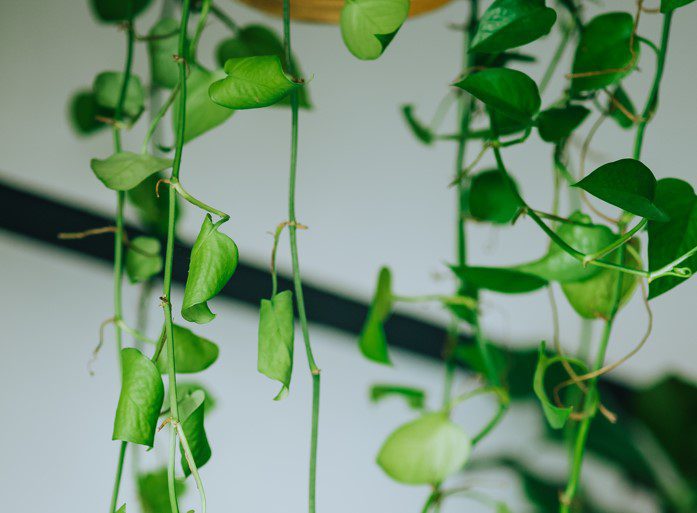Devil’s Ivy – Epipremnum Aureum
Devil’s ivy is a plant with multiple names. Known as a golden pothos, Ceylon creeper, Scindapsus aureus, or you may even have been sold it as a philodendron, which provides lots of confusion amongst botanists and houseplant lovers as well.
Devil’s ivy is different from the Aroid family, which includes peace lilies or monstera. Its golden-green variegated foliage and ability to survive in shallow light are what set it apart.
It can even survive in darkness for a while, where its connection to the underworld comes from.
It can grow over 15m in the wild, and its leaves are as large as dinner plates. A plant that is 2m-3m tall and has hand-sized leaves would be more realistic at home.
Devil’s ivy is happiest when it can cling to something. Traditionally, it would have a moss pole to climb up, but any hard, organic material will work.
It will trail over the side of a pot for some time. But in the end, the long dangling stems will begin to climb back up the plant itself.
PROPAGATION
Find a trailing stem that’s 30cm or longer, a medium plastic nursery pot, peat-free organic compost, and a stone, pebble, or unfolded paper clip.
Check your chosen stem is long enough to reach out of its existing pot and sit on top of the new pot, with some length to spare. Carefully remove one or two of the leaves from the middle section of the stem.
Fill the new pot two-thirds full with compost, then lower the stem in. Hold it in place and fill up the pot.
Firm the compost and pin the stem in place with the pebble or paper clip and keep moist. When the stem has made roots, cut your new Devil’s ivy from its parent.
Typically, Devil’s Ivy will grow to heights of 4 to 6 feet indoors. They may also be grown in hanging baskets or pots and enjoyed as trailing plants.
Plants can easily be pruned (tips of the stems) to limit their size.
The leaves of Devil’s Ivy are leathery, shiny, and oval- to heart-shaped. The bright green leaves are often irregularly marked with yellow or marbled with white depending on the variety.
Several varieties are readily available
Devil’s Ivy tolerates bright to low light conditions. Thus, plants can be placed 4 to 8 feet away from a window or other light source and thrive. The plants also do fine under artificial light.
Due to their low light requirements are often used in hotel lobbies and other commercial buildings as filler plants in an indoor landscape.
This attractive, fine-textured, low-maintenance foliage plant is popular. It has no real pest problems and is among the easiest indoor plants to grow.
Final Word
- The glossy, heart-shaped leaves of the Devil’s ivy are renowned for their quick growth.
- They are perfect for small spaces and the living room or kitchen because they flourish in various environments. How will you care for them over the winter?
- Although pothos can adapt to their surroundings, they must not be overwatered to remain healthy.
- Because pothos plants have a shallow root system, it’s best to follow the maxim “less is more” when watering them in the winter.
- Aim to softly water the area around the pot every two weeks.
- To prevent rotting, the soil must dry out between watering.
- Devil’s ivy can endure both high and low light levels. As a result, plants can be positioned 4 to 8 feet away from a window or other source of light and still grow.
- The plants thrive under artificial light as well.
- The popularity of this lovely, fine-textured, low-maintenance leaf plant. It is one of the rudimentary indoor plants to grow and has no significant pest issues.


























